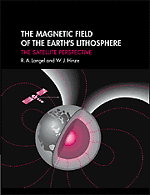Book contents
- Frontmatter
- Contents
- Preface
- 1 LITHOSPHERIC MAGNETIC FIELDS AT SATELLITE ALTITUDE
- 2 EARTH'S MAGNETIC FIELD
- 3 MEASUREMENT OF THE NEAR-EARTH MAGNETIC FIELD FROM SPACE
- 4 ISOLATION OF ANOMALY FIELDS
- 5 REDUCTION AND INVERSION
- 6 ANOMALY MAPS
- 7 MAGNETIC ANOMALIES AND THEIR SOURCES
- 8 METHODS IN INTERPRETATION
- 9 GLOBAL SATELLITE MAGNETIC ANOMALY INTERPRETATION
- Glossary of Symbols
- Common Abbreviations
- References
- Index
- Plate section
9 - GLOBAL SATELLITE MAGNETIC ANOMALY INTERPRETATION
Published online by Cambridge University Press: 06 December 2010
- Frontmatter
- Contents
- Preface
- 1 LITHOSPHERIC MAGNETIC FIELDS AT SATELLITE ALTITUDE
- 2 EARTH'S MAGNETIC FIELD
- 3 MEASUREMENT OF THE NEAR-EARTH MAGNETIC FIELD FROM SPACE
- 4 ISOLATION OF ANOMALY FIELDS
- 5 REDUCTION AND INVERSION
- 6 ANOMALY MAPS
- 7 MAGNETIC ANOMALIES AND THEIR SOURCES
- 8 METHODS IN INTERPRETATION
- 9 GLOBAL SATELLITE MAGNETIC ANOMALY INTERPRETATION
- Glossary of Symbols
- Common Abbreviations
- References
- Index
- Plate section
Summary
Langel, Benson, and Orem (1991) documented more than 400 publications based on Magsat data, including contributions to 9 books, 20 theses, and over 250 peer-reviewed journal articles. That does not include studies based on data from other satellite missions (e.g., Cosmos 49 or POGO). Also, additional papers have been published since the compilation by Langel et al. (1991). The portion of that literature addressing study of the lithosphere is diverse in quality and is neither comprehensive nor unified. In this chapter, selected results from that literature are discussed, chosen because of their contributions to our understanding of the lithosphere and because they illustrate interpretive methods. It is beyond the scope of this book to consider all regions or all published results. Four regions are considered: North America, Australia, Russia/Europe, and selected topics concerning oceanic areas. For each region, the distribution of either ζ (susceptibility times thickness), from the SEMM-1 model (Figure 8.22), or the equivalent source magnetization is discussed as it relates to the known geology and tectonics, followed by a review of published interpretations of the satellite data for the region. A simplified version of the geologic time scale is shown in Table 9.1 for reference. For cross-reference purposes, numbers in curly brackets, {}, refer to the maps listed in Table 6.1. Lists of publications by region are given in Appendix 9.1.
- Type
- Chapter
- Information
- The Magnetic Field of the Earth's LithosphereThe Satellite Perspective, pp. 312 - 382Publisher: Cambridge University PressPrint publication year: 1998



